Blood fluke - Study guides, Revision notes & Summaries
Looking for the best study guides, study notes and summaries about Blood fluke? On this page you'll find 83 study documents about Blood fluke.
All 83 results
Sort by
 Popular
Popular
-
MISSOURI BOATING LICENSE EXAM | QUESTIONS & ANSWERS (VERIFIED) | LATEST UPDATE | GRADED A+
- Exam (elaborations) • 66 pages • 2024
-
- £11.82
- 1x sold
- + learn more
1 MISSOURI BOATING LICENSE EXAM | QUESTIONS & ANSWERS (VERIFIED) | LATEST UPDATE | GRADED A+ Bow Correct Answer: Front of the vessel. Stern Correct Answer: Rear of the vessel. Starboard Correct Answer: Right side of the vessel. Port Correct Answer: Left side of the vessel. Hull Correct Answer: Body of the vessel. Gunwale Correct Answer: Upper edge of vessel's side. 2 Cleat Correct Answer: Metal fitting on which a rope can be fastened. Propeller Correct Answer: Rotates and ...
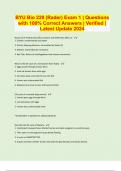 Popular
Popular
-
BYU Bio 220 (Rader) Exam 1 | Questions with 100% Correct Answers | Verified | Latest Update 2024
- Exam (elaborations) • 7 pages • 2023 Popular
-
- £8.27
- 1x sold
- + learn more
Name the 4 Protista that affect humans and HOW they affect us - 1. Giardia- contaminated cold water 2. African Sleeping Sickness- transmitted by Tsetse fly 3. Malaria- transmitted by mosquitos 4. Red Tide- Bloom of dinoflagellates that release neurotoxins What is the life cycle of a trematode? (liver fluke) - 1. Eggs passed through human feces 2. snail eat human feces with eggs 3. Cercariae leave snail and burrow into fish 4. Human eat undercooked fish 5. Metacercaria move to liver a...
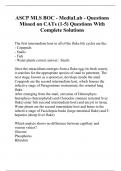
-
ASCP MLS BOC - MediaLab - Questions Missed on CATs (1-5) Questions With Complete Solutions
- Exam (elaborations) • 102 pages • 2023
-
- £14.19
- + learn more
The first intermediate host in all of the fluke life cycles are the: - Copepods - Snails - Fish - Water plants correct answer: Snails Once the miracidium emerges from a fluke egg (in fresh water), it searches for the appropriate species of snail to penetrate. The next stage, known as a sporocyst, develops inside the snail. Copepods are the second intermediate host, which houses the infective stage of Paragonimus westermani, the oriental lung fluke. After emerging from the snail, cercar...
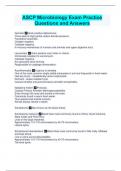
-
ASCP Microbiology Exam Practice Questions and Answers
- Exam (elaborations) • 33 pages • 2024
- Available in package deal
-
- £11.43
- + learn more
Gemella Gram positive diplococcus. Thrive best at high partial carbon dioxide pressure. Facultative anaerobe. Oxidase negative. Catalase negative. In mucous membranes of humans and animals and upper digestive tract. Leuconstoc Gram positive cocci often in chains. Intrinsically resistant to vancomycin. Catalase negative. Are generally slime forming. Responsible for cabbage fermentation. Acanthamoeba A genus of amoeba One of the most common single celled eukaryotes in soil and ...
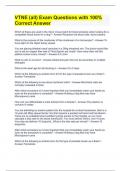
-
VTNE (all) Exam Questions with 100% Correct Answer
- Exam (elaborations) • 97 pages • 2024
- Available in package deal
-
- £20.10
- + learn more
Which of these are used in the minor cross-match for blood products when looking for a compatible blood donor for a dog? - Answer-Recipient red blood cells, donor plasma What is the purpose of the condenser of the condenser of a microscope? - Answer-To focus light on the object being viewed You are placing bilateral nasal cannulas in a 36kg shepherd mix. The doctor would like you to set an oxygen flow rate of 75mL/kg/min per nostril. How many liters will this patient receive every minute? ...
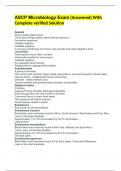
-
ASCP Microbiology Exam (Answered) With Complete verified Solution
- Exam (elaborations) • 29 pages • 2023
-
- £10.40
- + learn more
ASCP Microbiology Exam (Answered) With Complete verified Solution Gemella Gram positive diplococcus. Thrive best at high partial carbon dioxide pressure. Facultative anaerobe. Oxidase negative. Catalase negative. In mucous membranes of humans and animals and upper digestive tract. Leuconstoc Gram positive cocci often in chains. Intrinsically resistant to vancomycin. Catalase negative. Are generally slime forming. Responsible for cabbage fermentation. Acanthamoeba A genus of amoe...
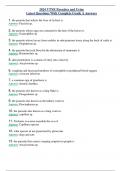
-
2024 VTNE Parasites and Urine Latest Questions With Complete Grade A Answers
- Exam (elaborations) • 10 pages • 2024
-
- £8.27
- + learn more
2024 VTNE Parasites and Urine Latest Questions With Complete Grade A Answers 1. the parasite that infects the liver of its host is Answer: Fasciola sp. 2. the parasite whose eggs are cemented to the hair of the horses is Answer: Gastrophilus sp. 3. the parasite whose larvae from warbles in subcutaneous tissue along the back of cattle is Answer: Hypoderma sp. 4. the parasite that suck blood in the abomasum of ruminants is Answer: Haemonchus sp. 5. skin penetration is a means of entry ...
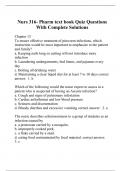
-
Nurs 316- Pharm text book Quiz Questions With Complete Solutions
- Exam (elaborations) • 29 pages • 2023
- Available in package deal
-
- £11.03
- + learn more
Chapter 13 To ensure effective treatment of pinworm infections, which instruction would be most important to emphasize to the patient and family? a. Keeping nails long so cutting will not introduce more infection b. Laundering undergarments, bed linens, and pajamas every day c. Boiling all drinking water d. Maintaining a clear liquid diet for at least 7 to 10 days correct answer: 1. b Which of the following would the nurse expect to assess in a patient who is suspected of having an Asc...
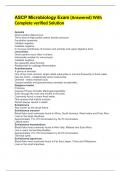
-
ASCP Microbiology Exam (Answered) With Complete verified Solution
- Exam (elaborations) • 29 pages • 2024
-
- £11.51
- + learn more
ASCP Microbiology Exam (Answered) With Complete verified Solution Gemella Gram positive diplococcus. Thrive best at high partial carbon dioxide pressure. Facultative anaerobe. Oxidase negative. Catalase negative. In mucous membranes of humans and animals and upper digestive tract. Leuconstoc Gram positive cocci often in chains. Intrinsically resistant to vancomycin. Catalase negative. Are generally slime forming. Responsible for cabbage fermentation. Acanthamoeba A genus of amoe...
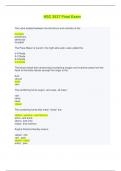
-
HSC 3537 Final Exam - Questions and Answers (Complete Solutions)
- Exam (elaborations) • 42 pages • 2024
-
- £18.53
- + learn more
HSC 3537 Final Exam - Questions and Answers (Complete Solutions) The valve located between the left atrium and ventricle is the: bicuspid pulmonary semilunar tricuspid The Pace-Maker is found in the right atria and is also called the: V-A Node A-V Node A-S Node S-A Node The blood vessel that carries blood containing oxygen and nutrients away from the heart to the body tissues (except the lungs) is the: duct venule aorta vein The combining forms angi/o- and vaso- all mean: vein valve heart ves...
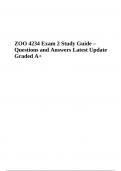
-
ZOO 4234 Exam 2 Study Guide – Questions and Answers Latest Update Graded A+
- Exam (elaborations) • 46 pages • 2023
- Available in package deal
-
- £12.22
- + learn more
ZOO 4234 Exam 2 Study Guide – Questions and Answers Latest Update Graded A+. Which of the following is a characteristic of Platyhelminthes? a) Most are parasitic b) Dorsoventrally flattened c) Triploblastic d) Acoelomate e) All of the above Which of the following is NOT a characteristic of Platyhelminthes? a) Triploblastic b) Parenchyma c) Pseudocoelomate d) Dorsoventrally flattened e) None of the above Which of the following is a class belonging to the Phylum Platyhelminthes? a) ...

How did he do that? By selling his revision notes on Stuvia. Try it yourself! Discover all about earning on Stuvia


